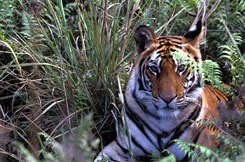|
Kanha National Park |
|
Kanha National Park is also called Tiger Land covering about 1940 sq km area located in the Mandla State of Madhya Pradesh. The park was created in 1955 by a special law and since then it has dedicated itself to pReserveing wildlife, saving many endangered species in the process. In 1974, it got the status of a tiger Reserve under the Project Tiger Scheme. This National Park owes thick vegetation in kinds of sal trees and bamboo forests and grasslands. |
| Bandhavgarh National Park |
|
|
It is a compact area national park situated in District - Umaria of Madhya Pradesh but full of game, having the highest tiger density in stretched over 448 sq kms is part of Bandhavgarh Tiger Reserve with the total area of 1161 square Kilometers. Biologically one of the most diverse tiger habitats with variety of ecosystems.
|
| Corbett National Park |
|
Situated in Kumaon hills in Nainital district, with picturesque hilly ridges covered by Sal trees, down hill are grasslands and bamboo forest, park is named after the famous hunter and naturalist, Jim Corbett who recounts many fascinating tales of hunting down man-eating tigers. |
| Namdapha National Park in India |
|
Namdapha Tiger Reserve is in Changlang District of Arunachal Pradesh which is spread in an area of 1,850-sq-kms rugged terrain. Perhaps no other national park in the world has a wider altitudinal variation than the Namdapha national park that rises from 200m to 4,500m in the snow-capped mountain. |
|
Kaziranga National Park |
|
Kaziranga Indian National park is situated in the north-eastern sector in the Province of Assam on the banks of the mighty river Brahmaputra.The Park is located in the Golaghat District of Assam and spread over an area of about 430sq.km. When there was alarming depletion of number of rhino due to haunting and poaching which led to conservation of this area in 1926. The park established as sanctuary in 1940, and by 1966 the rhino numbers had risen to about 400. Though they are still threats by pilferers and floods, the population of these great beasts is now touching 1500. |
|
Manas National Park |
|
Manas Tiger Reserve, lies in the foothills of the Himalayas in India in the northeastern state of Assam. Manas derives its name from the Goddess Manasa. The forest stretches beyond Indian territory to the Himalayan kingdom of Bhutan The crystal waters of the Manas River demarcating the international border. Some areas that adjoin the river path are often flooded but water level subsides after the rainfall being slop in the landscape. There is heavy rain fall hence the forests are dense and prevent the sun rays to enter. |
| Periyar National Park |
|
Situated within the confines of the Western Ghats in the southern Indian state of Kerala, Periyar National Park and Tiger Reserve is one of the most captivating wildlife parks in the world. The picturesque lake in the heart of the sanctuary was originally 26 sq km but now spans an area of 55 sq km. This perennial source of water, which initially led to the submersion of large tracts of forestland, slowly attracted wild animals. It eventually resulted in the adjoining forests being granted protection by the Maharaja of Travancore. Post-Periyar National Park 975 Periyar finds itself in the enviable position of being a national park as well as a protected tiger Reserve.
|
| Bandipur National Park |
|
The Bandipur National Park is most interesting wild-life center. Established in 1931 by the Maharajha of Mysore , this park lies in the foothills of Nilgiris. |
| Panna National Park |
|
Panna National Park is situated in the Central Indian state called Madhya Pradesh.
This park is located at a distance of 57 kms from Prominent Tourist Place Khajuraho which is the nearest Air Port. Distances of some important places in India from the Panna National Park are Bhopal 727 km, Delhi 889 km, Chennai 1761, and Calcutta 1040 km. |
| Ranthambore National Park |
|
This park is located near Sawai Madhopur , Rajasthan and was initially established as a sanctuary in 1959 and included in the very first phase of Project Tiger in 1972. In 1981 Ranthambore was awarded National Park status. The park derives its name from the fort of Ranthambhore which is built on a rocky outcrop in the forest.
|
Simlipal National Park |
|
Location : Mayurbhanj, Orissa
The Simlipal National Park in Orissa was given status of Tiger Reserve in 1956 and in 1972 it became a part of the Project Tiger Scheme followed by the stratus of the national park in 1979. This national park and tiger Reserve in northern Orissa is covered with the wide stretches of sal forests. The national park is home to twelve rivers and innumerable waterfalls and the native Santhal tribes of Orissa. |



